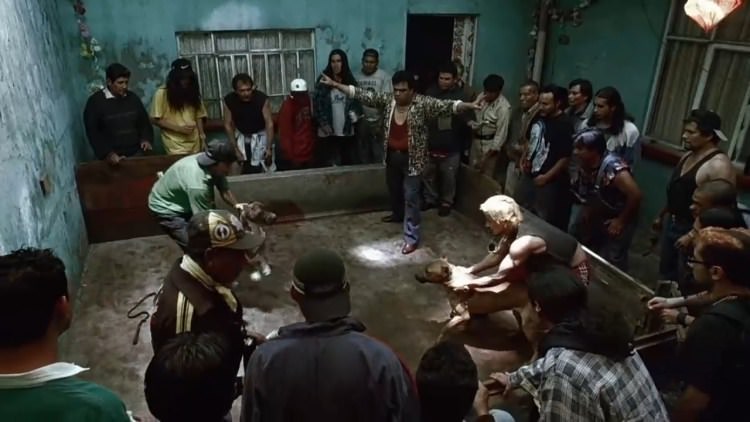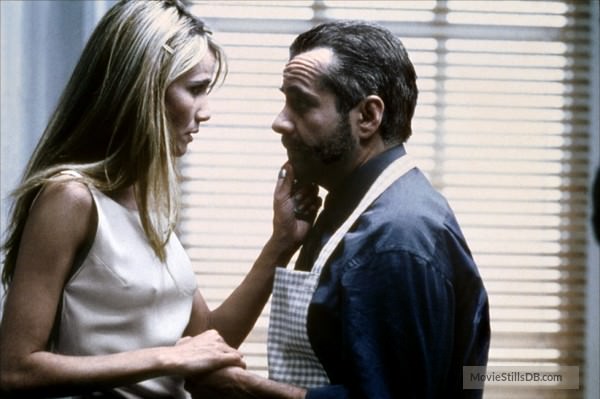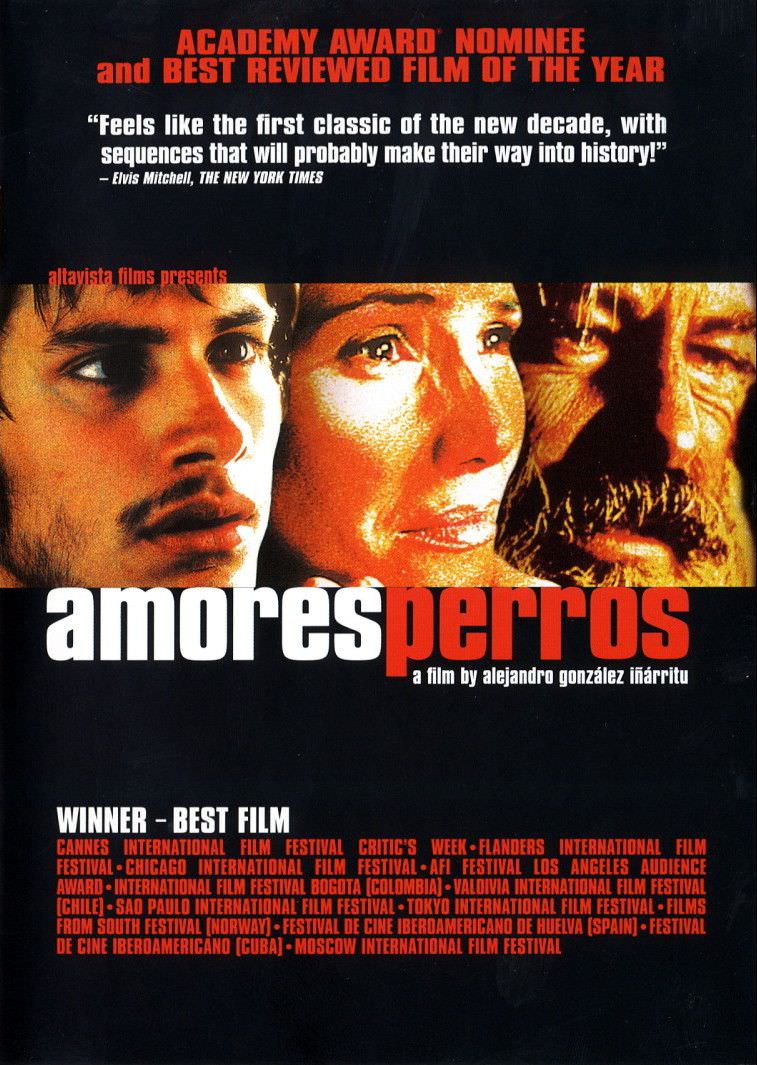Amores Perros
Alejandro Iñárritu’s first feature film is a Mexican crime drama whose title could be roughly translated as “Love’s a Bitch”. The title’s ironic, because as much love is shown in the movie by humans to dogs than to other humans. You may also find yourself rooting more for the dogs than some of the cruel characters exhibited.
 The 153-minute look at Mexico City nineteen years ago begins with a car crash, where all the divergent stories the film tells will converge. (Did Amores Perros influence the weaker and preachier Crash (2005)?) Amores‘ first story, “Octavio y Susana” is a tale of the lower-class Octavio (Gael García Bernal), in love with the wife, Susana (Vanessa Bauche), of his thuggish and abusing brother Ramiro (Marco Pérez). Octavio tries to convince Susana to run away with him, to no avail. Meanwhile, another local thug, Jarocho (Gustavo Sánchez Parra), involved in dog fighting competitions, allows his killer dog to attack Octavio’s rottweiler, Cofi, but his own dog is killed instead. Threatening Octavio to come up with the money to pay for his dead dog, Jarocho puts on the pressure, forcing Octavio to enter the dog fighting arena himself. Although the producers claim no animals were harmed during the production of the film, the fights are ferocious, vicious-looking spectacles. Amores may have been influential in the 2017 outlawing of dog fighting in Mexico.
The 153-minute look at Mexico City nineteen years ago begins with a car crash, where all the divergent stories the film tells will converge. (Did Amores Perros influence the weaker and preachier Crash (2005)?) Amores‘ first story, “Octavio y Susana” is a tale of the lower-class Octavio (Gael García Bernal), in love with the wife, Susana (Vanessa Bauche), of his thuggish and abusing brother Ramiro (Marco Pérez). Octavio tries to convince Susana to run away with him, to no avail. Meanwhile, another local thug, Jarocho (Gustavo Sánchez Parra), involved in dog fighting competitions, allows his killer dog to attack Octavio’s rottweiler, Cofi, but his own dog is killed instead. Threatening Octavio to come up with the money to pay for his dead dog, Jarocho puts on the pressure, forcing Octavio to enter the dog fighting arena himself. Although the producers claim no animals were harmed during the production of the film, the fights are ferocious, vicious-looking spectacles. Amores may have been influential in the 2017 outlawing of dog fighting in Mexico.
 Amores‘ second tale, “Daniel y Valeria”, may remind you of how quickly life can go wrong. A celebrity supermodel, Valeria (Goya Toledo), moves into a new apartment with her magazine-editor lover, Daniel (Álvaro Guerrero) – who’s just left his wife and family for her — and her beloved dog, Richie. She soon after breaks her leg in the aforementioned car crash and it looks like her modeling career may be over (a large perfume billboard ad featuring her and her long legs leers over their apartment from across the street). Then, Richie jumps into a hole in their unfinished living room and doesn’t come back. Daniel and Valeria can hear the dog, but cannot see it; they do, however, see huge rats underneath the floor boards. The weird tale has shades of the Twilight Zone “Little Girl Lost” and symbolism reminiscent of “The Tell Tale Heart”.
Amores‘ second tale, “Daniel y Valeria”, may remind you of how quickly life can go wrong. A celebrity supermodel, Valeria (Goya Toledo), moves into a new apartment with her magazine-editor lover, Daniel (Álvaro Guerrero) – who’s just left his wife and family for her — and her beloved dog, Richie. She soon after breaks her leg in the aforementioned car crash and it looks like her modeling career may be over (a large perfume billboard ad featuring her and her long legs leers over their apartment from across the street). Then, Richie jumps into a hole in their unfinished living room and doesn’t come back. Daniel and Valeria can hear the dog, but cannot see it; they do, however, see huge rats underneath the floor boards. The weird tale has shades of the Twilight Zone “Little Girl Lost” and symbolism reminiscent of “The Tell Tale Heart”.
The last story, “El Chivo y Maru”, features a character who’s life already intersected with the first two, El Chivo (Emilio Echevarría), a hit-man who takes the form of a down and out vagrant. A school teacher in his earlier life, he left his profession and family to join a rebel guerrilla movement, then spent time in jail. He’s estranged from his now-adult daughter, Maru (Lourdes Echevarria) and loves his many dogs (he defended them with a machete earlier when Jarocho was looking for a dog fight). “El Chivo” weaves the earlier stories together and leaves the film with a somewhat hopeful note.
 Each section of Amores is filmed in keeping with its subject matter and social strata; “Octavio y Susana”, for example, is shot nearly cinéma vérité-style, in keeping with its fast, street-level conflicts. “Daniel y Valeria”, on the other hand, transpiring at high levels of Mexico City income, is shot streamlined and nearly glossy. All show the attention to detail and human interest utilized so well in Iñárritu’s later US films like Birdman or The Unexpected Virtue of Ignorance (2014) and The Revenant (2015).
Each section of Amores is filmed in keeping with its subject matter and social strata; “Octavio y Susana”, for example, is shot nearly cinéma vérité-style, in keeping with its fast, street-level conflicts. “Daniel y Valeria”, on the other hand, transpiring at high levels of Mexico City income, is shot streamlined and nearly glossy. All show the attention to detail and human interest utilized so well in Iñárritu’s later US films like Birdman or The Unexpected Virtue of Ignorance (2014) and The Revenant (2015).
A radio DJ before he was a filmmaker, Iñárritu weaves Latin pop music through the film to great effect. The S Studio DVD features three music videos and a barrage of extras: storyboards and photos, nearly a half hour of deleted scenes, two featurettes, a production commentary track and a trailer. The commentary track, featuring Iñárritu and the screenplay’s author, Guillermo Arriaga Jordan, details how carefully and thoughtfully the story was structured and directed (William Faulkner’s The Sound and the Fury was the initial inspiration for the story’s shape). Amores Perros was nominated for the 2001 Academy Award for Best Foreign Language Film.
—Michael R. Neno, 2019 May 09